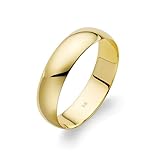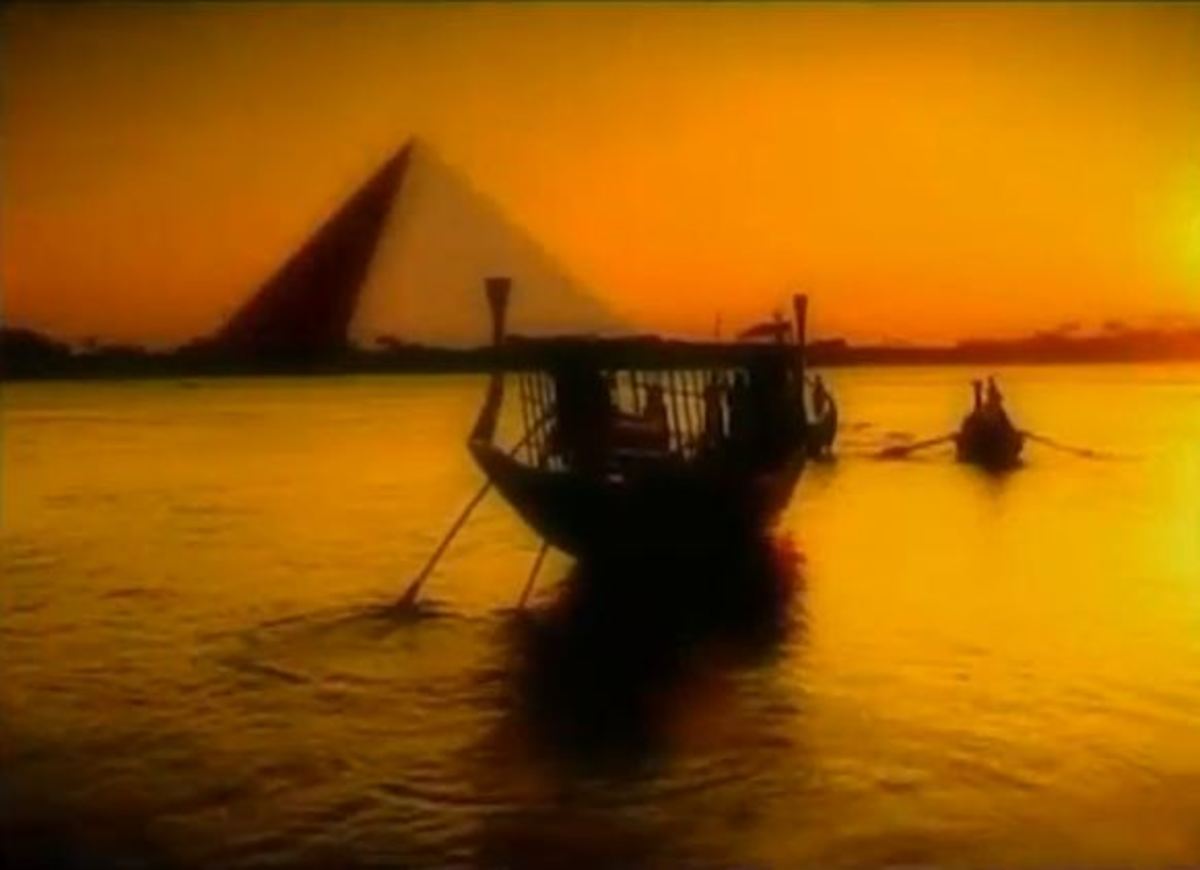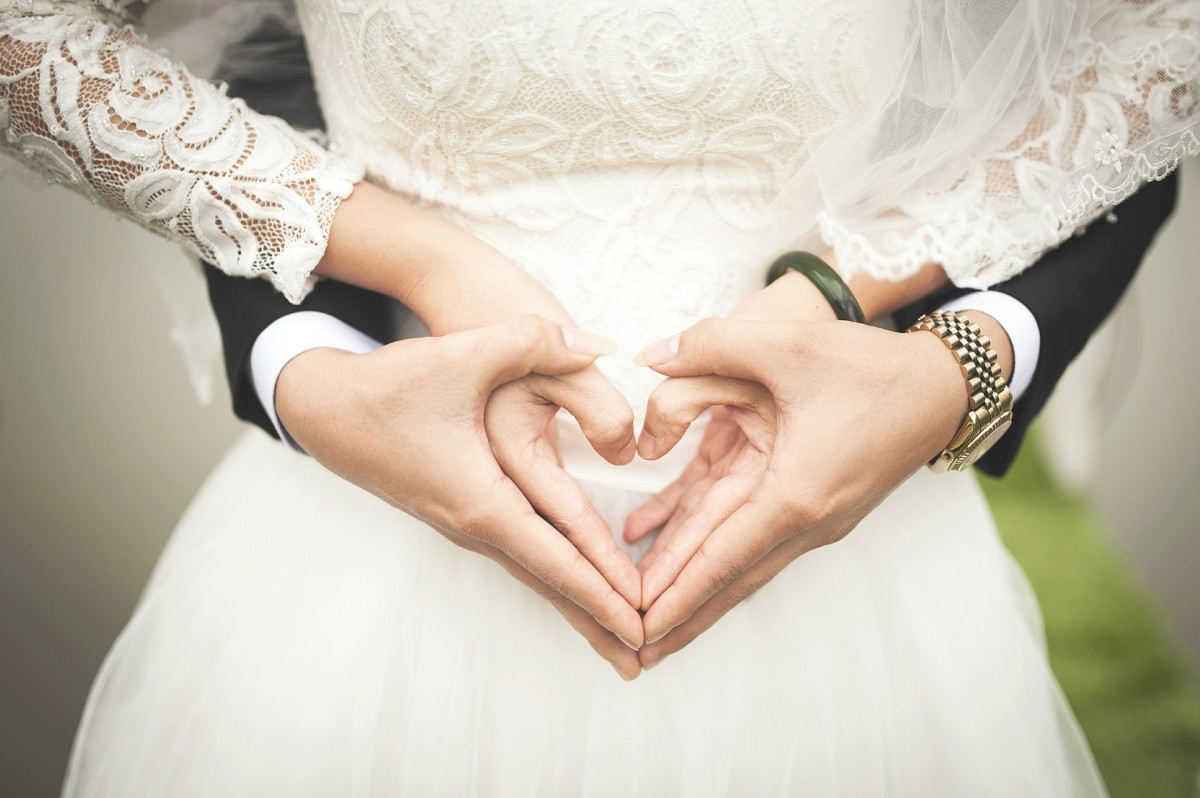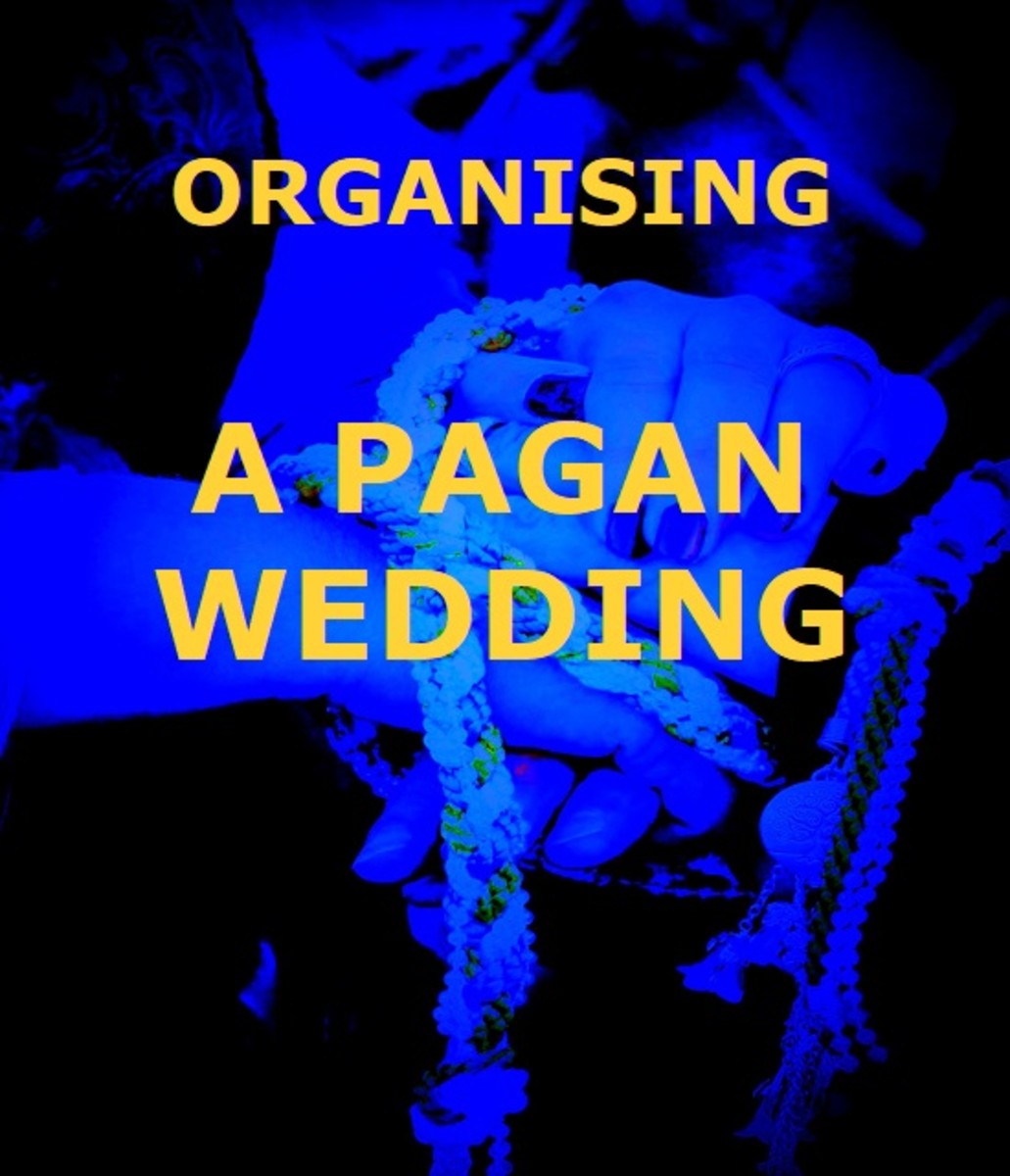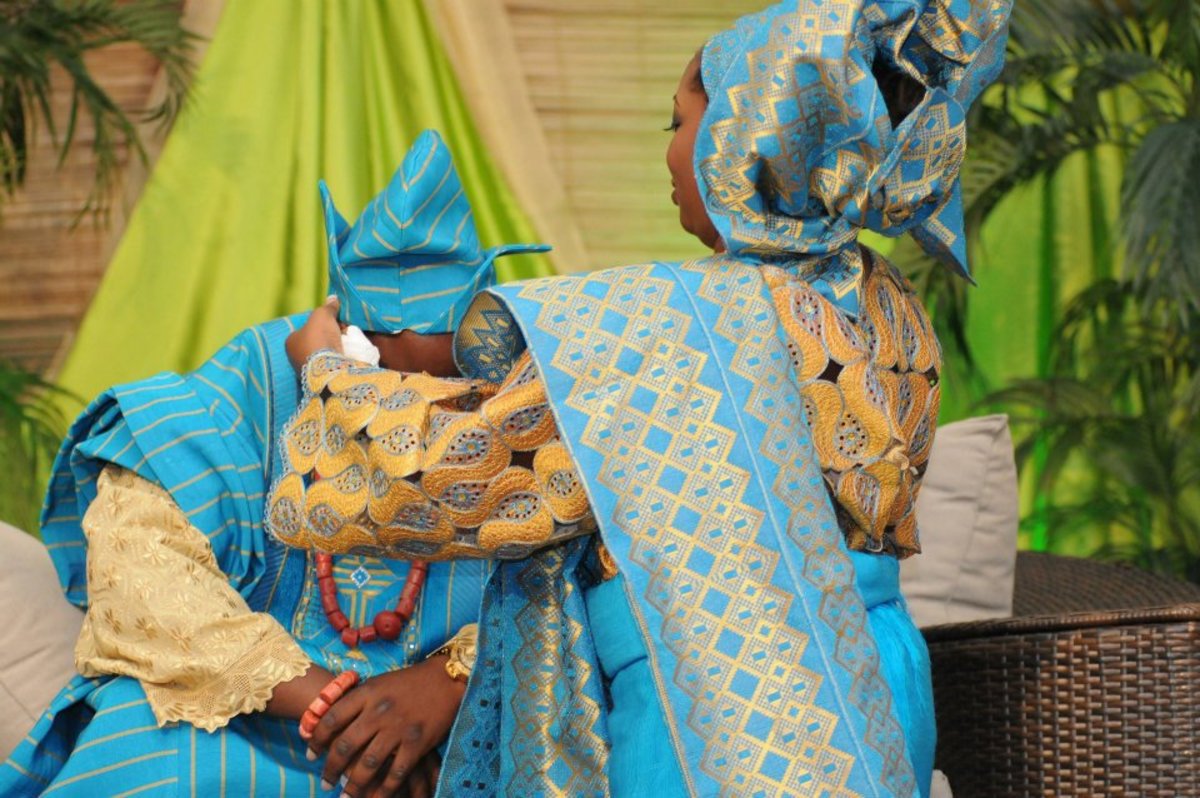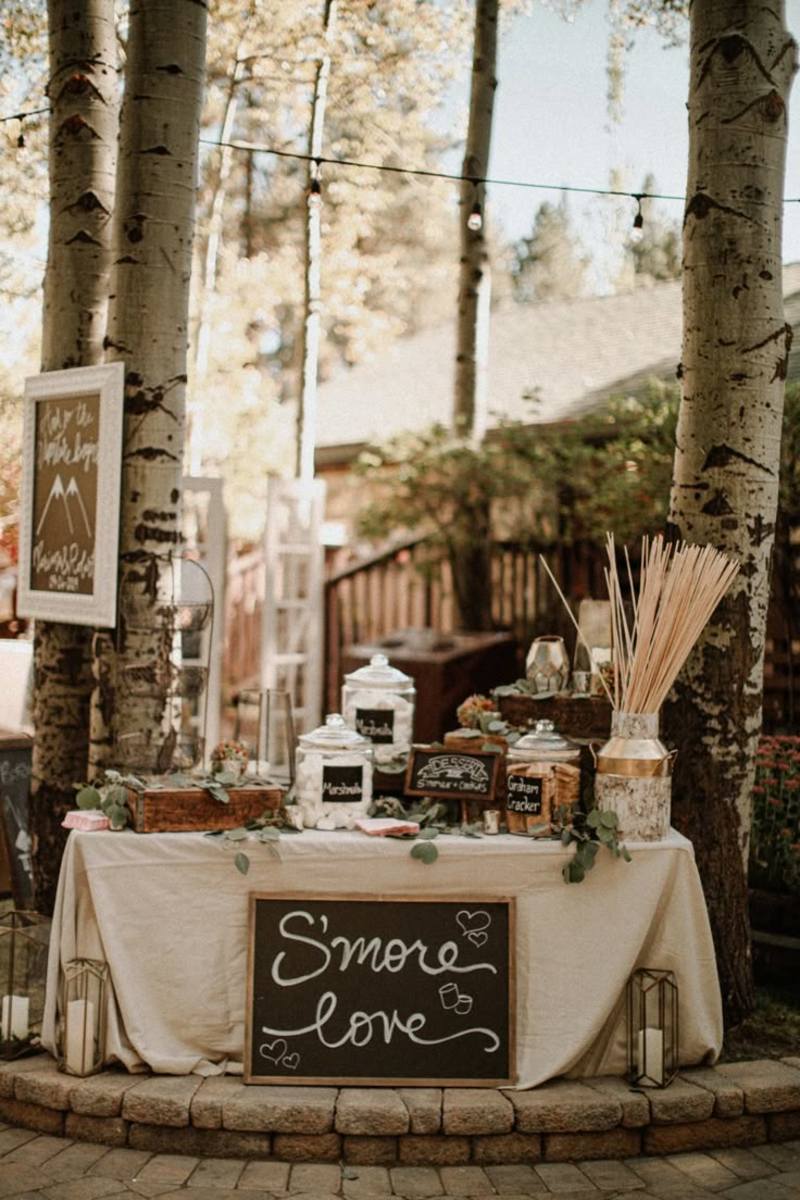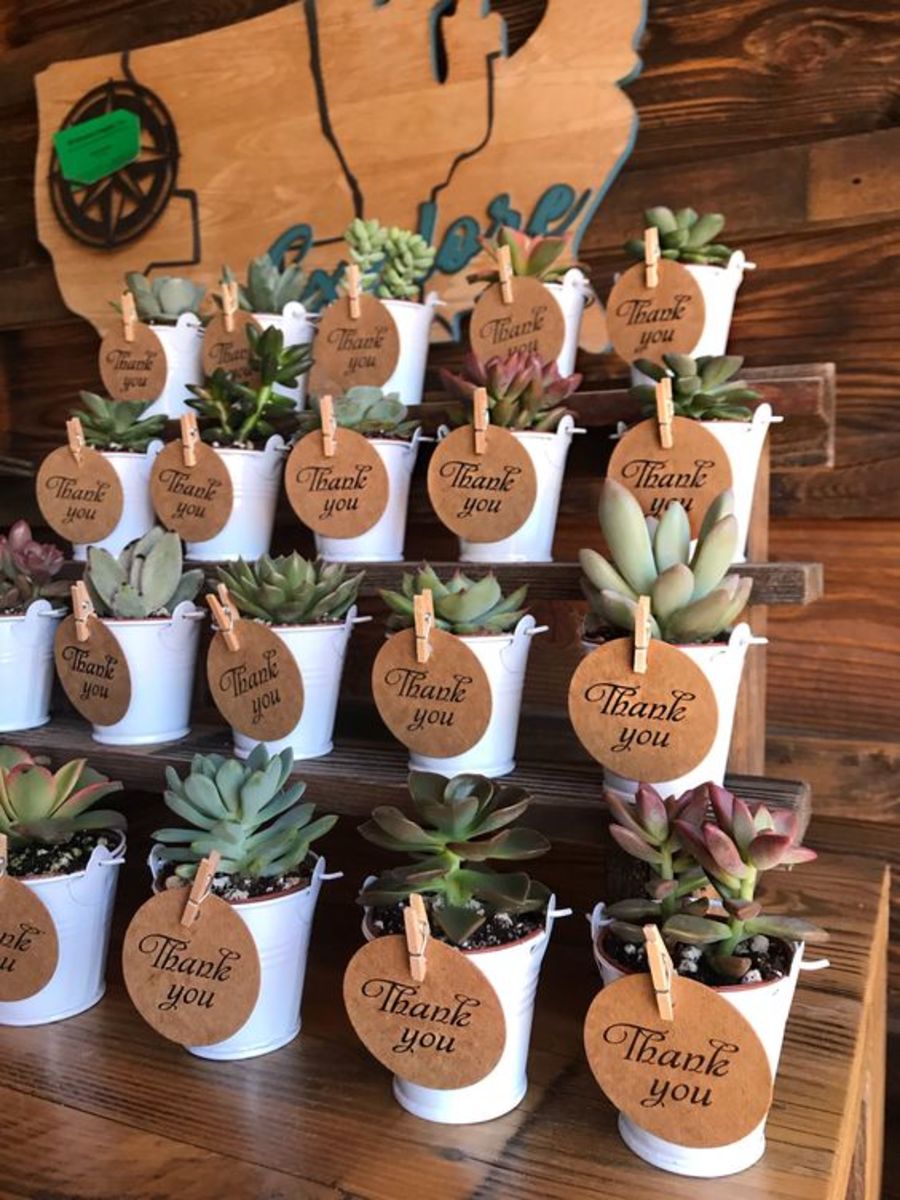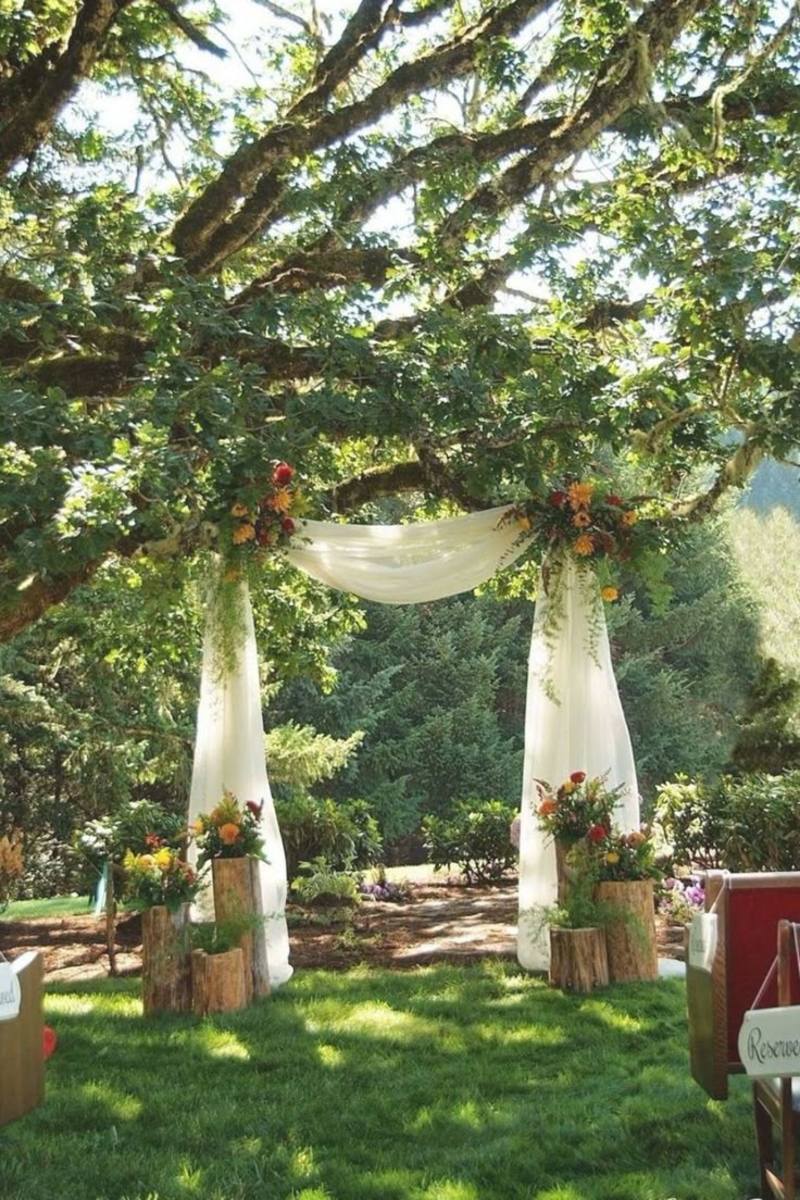The Wedding Ring: A Brief History
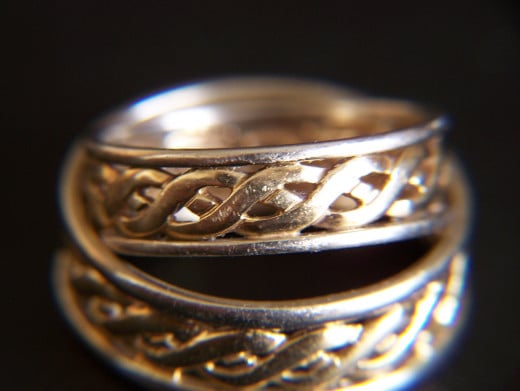
“In marriage there are no manners to keep up, and beneath the wildest accusations no real criticism. Each is familiar with that ancient child in the other who may erupt again. We are not ridiculous to ourselves. We are ageless. That is the luxury of the wedding ring.” ~ Enid Bagnold
"With this ring I thee wed." There is nothing more symbolic during a marriage ceremony than the exchanging of wedding rings between a couple. This meaningful exchange is a sign of unity, commitment and above all else, love.
Prehistoric Ancestors
The wedding ring is one of the oldest nuptial traditions known to man. It is believed that our prehistoric ancestors would tie rushes, twigs and grass around ankles and wrists of the bride. This symbolized friendship and loyalty and was meant to give the bride longevity and protect the soul.
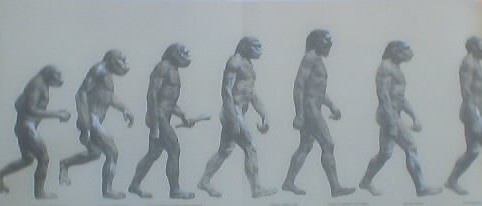
Ancient Egyptians
However, according to historical evidence, the use of a wedding ring actually occurred in Ancient Egypt. During archaeological excavations, artifacts dating back more than 4000 years were discovered indicating the birth of the wedding ring.
Papyrus scrolls show drawings of rings braided from reeds and hemp being exchanged between Egyptian couples. Rings were also made from bone, leather and ivory. Some time later, Egyptians realized that metal could be used to make rings. It was believed that when a woman received a metal ring, she would have claim to all of her husband's possessions.
Archaeologists discovered, by studying hieroglyphics, that the ancient Egyptians believed that the circle was symbolic of perpetual love between a woman and a man. For this reason Egyptians wore their wedding bands on their left hand ring finger believed to have the vein which led directly to the heart. The ring was also symbolic of eternity for Egyptians and other ancient cultures. The circle was representative of time that had no end. The center or hole of the circle was also regarded as a gateway to the known and unknown.
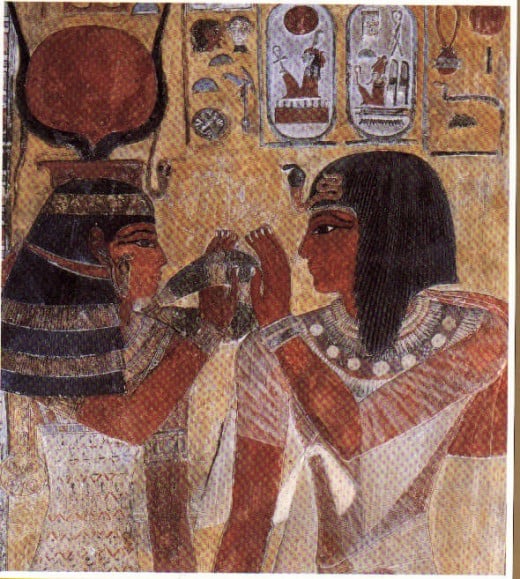
Ancient Romans
This belief was adopted by other cultures and passed down throughout the years. In Ancient Roman times, exchanging of rings took on an entirely different meaning. Early Romans believed that the exchange of a ring was more about ownership of a woman rather than that of commitment and love. During this time, marriages were based on social classes and there were primarily three types of unions practiced. They were Confarreatio, Coemptio and Usus.
Confarreatio was a traditional patrician form of marriage. In the beginning, only those whose parents were joined in this type of union were allowed to marry in the same way. The bride went directly from the hand of her father (paterfamilias) to the hand of the groom. The marriage rite of Confarreatio derived from the latin words "panis farreus" which was a cake made of spelt that the couple shared during the ceremony. The ceremony was presided over by the Flamen Dialis and Pontifex Maximus and had to be witnessed by at least 10 people. Confarreatio was reserved for the wealthy and was considered the only legal form of marriage at the time.
In a Coemptio union which was considered a "mutual purchase", a Roman man and woman delivered money to each other for the purpose of joining in marriage. The man would ask the woman if she would be his "Materfamilias" or "Mistress of the Family" and she would likewise ask him if he would be her "Paterfamilias" or "Master of the Family". Historians believe that the exchange of money was more symbolic than anything else. However, a father was paid a sum of money for their daughter's hand in marriage.
The Unus union did not require a wedding ceremony. Essentially, a woman would have the hand or "manus" of her husband after cohabiting with the man for a certain period of time. In today's society, this is known as a Common-law marriage. Often there was intent from the beginning of the relationship or "adfectus maritalis". As a prerequisite, the couple had to live with one another for a minimum of one year. However, if within that year the woman left the home for three consecutive days, the arrangement would become null and void. Primarily, Usus was an informal union reserved for the lowest class of Romans.
Unlike the Egyptians who believed the ring was a symbol of love, historians believe the Romans viewed the wedding band as a symbol of possession. In other words the bride now "belonged" to the groom. Surprisingly, the Romans also placed the band on the fourth finger of the left hand and coined the phrase "Vena Amoris", a Latin term for "vein of love". Difficult to understand when the word "possession" comes into play. Scientific proof has since ruled out this theory.
Over time the Roman betrothal rings were made of iron and called “Anulus Pronubus.” The iron rings were symbolic of strength and perpetuity. This ultimately introduced the use of metals for rings. Wedding rings were worn by women only. Brides were given gold rings by their husbands which were worn in public. While at home they would wear their iron ring. Romans were also considered the first to engrave their rings.
In contrast, as time progressed the wedding ring became more symbolic of romance for the Romans. Much like the Egyptians long before them, the bride now had a right to her husband's possessions. It was also symbolic of the bride possessing the key to the groom's heart. To showcase this belief, a wedding ring was constructed with a key attached to it.
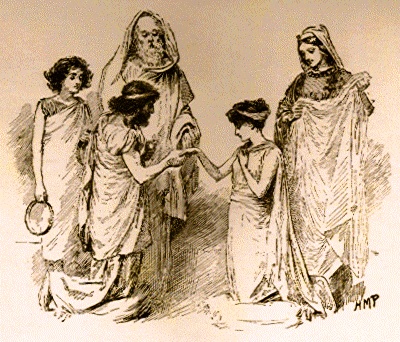
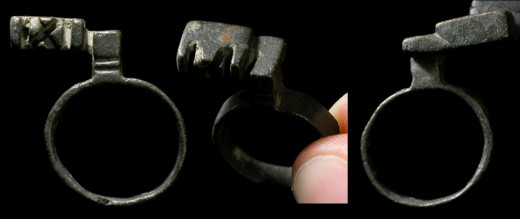
Early Christians
By the time 800AD rolled around, Christians were using the exchange of wedding rings as part of their wedding ceremonies. The rings were very ornate and elaborate, however by the 13th century, the church opposed the use of such rings as they were deemed too secular. As a result, a more modest and spiritual ring was introduced for weddings and betrothals. Also, in 13th century England and Ireland, using rings during the wedding ceremony was paramount owing to their spiritual meaning. It was considered so important that if the groom was too poor to buy a ring, he would have to borrow or rent one. In Ireland, it was considered bad luck and illegal if the ring was not made of gold. Over time, this myth was dispelled as mere folklore.
During early Christian wedding ceremonies, the ring was placed on the third finger. The reason for this practice was so that the priest could give the blessing of, ”In the name of the Father, the Son and the Holy Spirit”, and then remove the ring and touch the thumb, the index finger, and the middle finger. Once the priest said “Amen”, he would place the ring on the fourth or ring finger, which sealed the union between the bride and groom.
During Colonial times in America, tokens of love and a promise of marriage were slightly different. At this period in time the use of jewelry was considered iniquitous and pompous. Fiancées were not given rings, instead they were given thimbles as a promise of marriage. Once the couple were wed, the thimble was made into a wedding ring.
Groom's Wedding Ring
The only known men to wear a wedding ring was during ancient Egyptian times. However, a small minority of men have worn wedding rings throughout the centuries. The use of the groom wearing a wedding band is a relatively recent practice. As previously discussed, the wedding ring has meant many different things to different cultures over time including possession of the bride. However, during WWII, it became fashionable and acceptable for men to wear a wedding ring. It was a means of remembering their loved one back home. Today, most men wear a wedding band. Nonetheless, there are still some men who choose not to wear a wedding ring even today. For example, Prince William chose not to wear a ring when he married Kate Middleton. On the other hand, his father, Prince Charles, chose to wear a wedding ring when he married Camilla Parker Bowles.
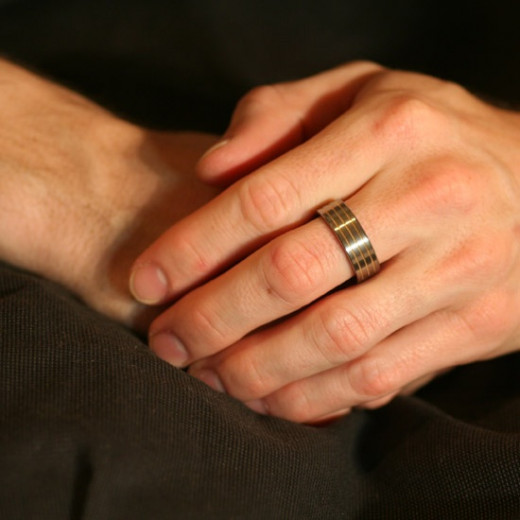
Modern Society
In modern times the concept of the wedding band and engagement ring has become a precious tradition. Today, wedding bands are made primarily of yellow gold, white gold and platinum. Many rings contain diamonds and are often custom made to the couple's personal preferences. In recent decades, however, wedding bands have become more personal and unique. There are some couples that choose to add gems, rubies, pearls or coloured diamonds to their rings.
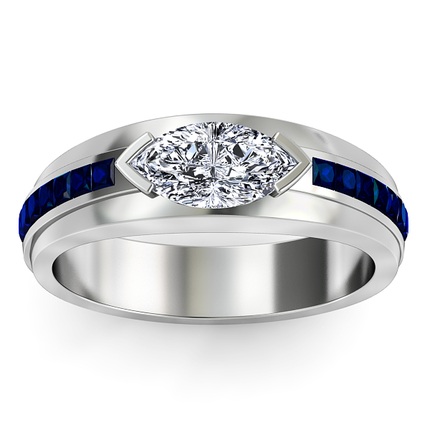
Interesting Facts
Did You Know?
1) The first recorded account of a diamond engagement ring was in 1477 when King Maximilian I of Germany (1459-1519) proposed to Mary of Burgundy (1457-1482) and offered her a diamond to seal his vow.
2) The smallest betrothal ring on record was given to two year old Princess Mary, daughter of Henry VIII, on the event of her engagement to the infant Dauphin of France, son of King Francis I, in 1518. The tiny gold ring, fitted to her finger, was set with a valuable diamond.
3) Can you believe that a whopping 17 tons of gold are used annually in producing wedding rings in the United States?!?
4) In the Jewish tradition, the ring is placed on the Bride's index finger by the groom. In and around the 13th Century Hebrew tradition was for the bride to wear a ring designed to look like a Jewish Temple rooftop. This symbolised the future of the couple and its roof was inscribed with the Hebrew words for ‘lucky star’. However, the ring was awkward in its size and shape.
5) There are many cultures today that wear the wedding ring on the right hand as opposed to the left. Couples in countries such as Germany, Norway, Russia, Bulgaria, Ukraine, Greece, Poland, Austria, Portugal and Spain wear their ring on the right hand.
6) The intertwining of gold and iron together became symbolic of unity, love and strength for a married couple.
7) In olden times, wedding rings were looked upon as contracts between two families and represented an exchange of valuables and goods during the ceremony.
8) It was customary In Persia, for the bridegroom to give a ring to everyone who attended the ceremony.
9) At Queen Victoria and Prince Albert's wedding, they gave out six dozen rings that were engraved with the queen's profile.
10) The use of "promise rings" dates back to 16th century Europe. These rings were given as a promise of marriage once the groom was able to acquire possessions and money to ultimately support his bride-to-be.
11) In olden times it was believed that a wedding ring had to be perfectly fitted or it would result in a bad future for the marriage. For example, a ring that was too tight was indicative of growing jealousy between the couple. A ring that was too loose could mean a possible separation for the couple at some point in their marriage.
12) During the seventeenth century, the Puritans attempted to eradicate the tradition of the wedding ring. They were unsuccessful in their efforts.
13) Did you know that there was a legend claiming that Joseph and Mary had used a wedding ring that was made of either onyx or amethyst? Various churches in Europe capitalized on this story centuries ago and claimed to have the ring in their possession which they said was capable of performing miracles. As a result, it attracted pilgrimages to their areas which brought in revenue.
14) Did you know that the concept that a man should spend at least a month's salary on an Engagement ring originated from the jeweler De Beers in the 1930s as a marketing ploy to increase sales? By the way, it is now two months salary.
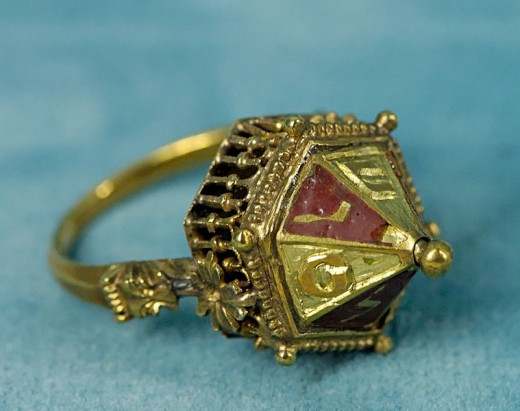
Types Of Wedding Rings Throughout The Centuries
Throughout the centuries, there were certain styles of rings that were quite popular. Here are just a few of those often unusual and valued rings.
The Puzzle Ring
The history of the Puzzle ring is as unusual as the ring’s design, and shrouded in myth, legend and theory. This ring has been and continues to be alluring primarily owing to its mysterious beginnings. A traditional puzzle ring is a type of ring made up of four, six, eight, or twelve interconnected rings.
One story of its origins takes place centuries ago in the Middle East. the puzzle rings were given by Sheiks and Chieftains. It is believed that they were given to a bride to ensure her fidelity. The only ones who knew the solutions to the ring was the husband. If the bride was unfaithful and removed her ring, it would fall apart. This would indicate to the groom that the wife cheated on him because she would not be able to put it back on. This is just one theory mind you.
This elegant ring has made somewhat of a comeback and is made in gold, silver or platinum and can be adorned with diamonds or other precious gemstones. The designs may vary slightly today but the elements remain primarily the same.
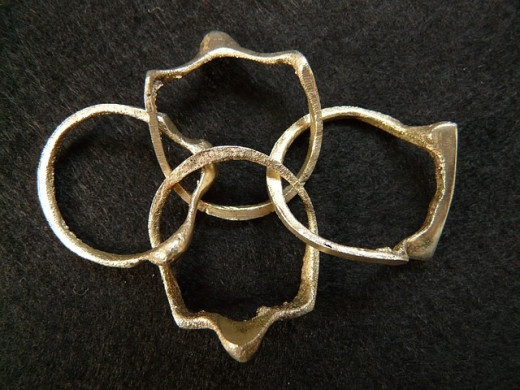
The Gimmel Ring
The Gimmel ring was popular in Europe during the 15th to 18th centuries. The word "fede" is an Italian word meaning "trust" and the clasped hands on the gimmel ring was symbolic of trust between the betrothed. This ring was often given as an Engagement ring. Essentially the ring was comprised of two silver or gold bands which were separated and worn by both the man and the woman. Once they were wed, the rings were joined together by a gold or silver smith for the bride to wear.
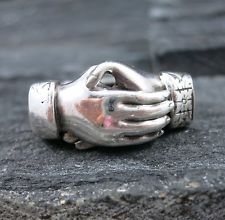
The Poesy Ring
The Poesy ring has its beginnings in classical times. Shakespeare's plays mention them such as Hamlet Act III, scene 2, "Is this a prologue or the poesy of a ring." This ring had a small love poem inscribed on the exterior or interior of the band. These rings were believed to possess magical powers. It is said that anyone that wore the ring would experience the sentiment of the poem inscribed on the ring.
In England and France during the 16th and 17th centuries silver betrothal rings were given with the poetic inscription. However, on the wedding day it was replaced with a gold inscribed poesy ring.
Historically, the Poesy ring reached its height of popularity during the Renaissance period. They were not only given on the wedding day but they were also given as a gift to a love interest or simply as a token of appreciation.
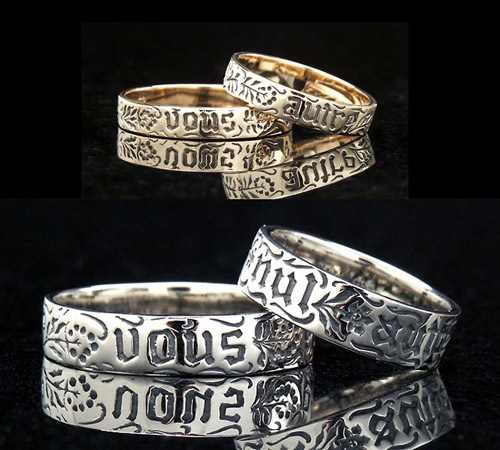
The Thimble Ring
The Thimble ring was popular during Colonial America. The practice started with the Puritans who believed that jewelry was considered prodigal and dissolute. Essentially, a groom would give his intended a thimble. It was considered a sign of undying love and devotion and above all else it was practical. However, once married many brides were creative and had the top of the thimble removed and made into a ring. Thus was the birth of the thimble ring.
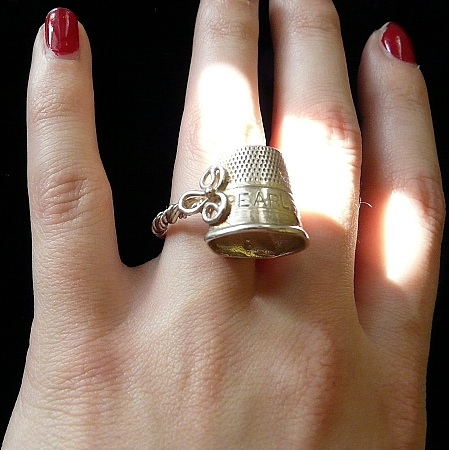
The Claddagh Ring
The Irish Claddagh ring is one of the most culturally rich and significant pieces of jewelry in history. The meaning, significance and history of the Claddagh ring dates back to over 400 years. The ring was often passed down from mother to daughter. The ring is still used today.
There are hands on the ring holding a heart, the hands mean friendship and togetherness, the heart signifies love and the crown in the claddagh ring stands for loyalty. The Claddagh ring makes an ideal choice for all occasions, wedding rings, birth stone rings, engagement rings, mothers day rings and rings for all occasions. The Claddagh ring is also referred to as faith rings. The Claddagh ring originated from a small fishing village in Ireland called Claddagh.
The way the Claddagh ring is worn also carries a great deal of significance. A person not involved in a relationship or perhaps has no desire to be in a relationship will wear the ring on the right hand with the crown pointing towards the heart. For a person looking for love, the ring is worn on the right hand with the crown pointing away from the heart. Finally, an engaged or married person wears the ring on the left hand with the crown pointing away from the heart.
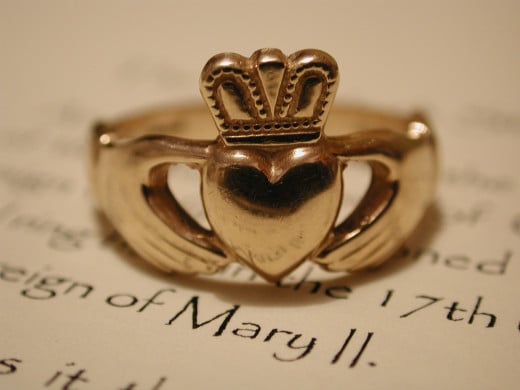
Asian Rings
Some Asian countries as well as countries in the Far East use pure yellow gold, (22 to 24 carat gold), for their wedding rings. It is thought that the use of pure gold stems from religious beliefs. However, in India pure gold has been associated with beauty and superiority. Also, pure gold lasts longer which is symbolic of a long lasting marriage. Traditionally, the bride receives a great deal of gold because it is believed that she will be happier.
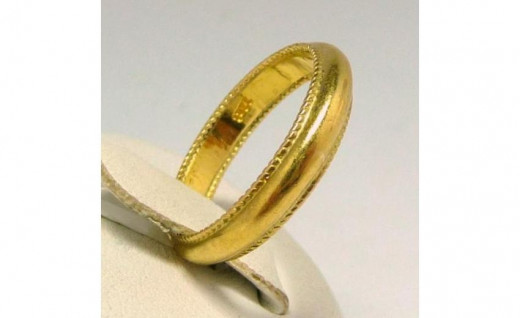
Finally........
Since the beginning of time, wedding rings have meant different things to different cultures and religions. Ultimately it has grown as a symbol of love, devotion, unity, commitment and is meant as an everlasting gesture between two individuals in love. I hope that you have enjoyed this look at the history of the most coveted piece of jewelry in the world, the wedding ring.
A Different Perspective On Why Ring Is Worn On Fourth Finger
QUESTION:
Which ring style from the past do you fancy?
You May Also Like
- 100 Fabulous Years Of Wedding Gowns
In this segment we are going to take a historical look at bridal gowns and how they have evolved throughout the years. It is interesting how elements from the past are incorporated in the present. I suppose history does repeat itself.

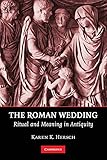
![Cavalier Jewelers 8MM Men's Titanium Ring Wedding Band Black Carbon Fiber Inlay and Beveled Edges [Size 10]](https://m.media-amazon.com/images/I/41iXISR1gIL._SL160_.jpg)
